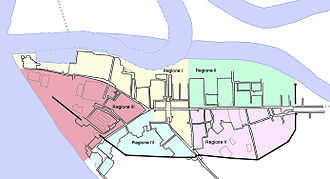Ostia Antica
Ostia is now a large archaeological site noted for the excellent preservation of its ancient buildings, magnificent frescoes and impressive mosaics.
[6] The most ancient buildings currently visible are from the 3rd century BC, notably the Castrum (military camp);[7] of a slightly later date is the Capitolium (temple of Jupiter, Juno and Minerva).
The opus quadratum of the walls of the original castrum at Ostia provide important evidence for the building techniques that were employed in Roman urbanisation during the period of the Middle Republic.
[8] Ostia probably developed originally as a naval base, and in 267 BC, during the first Punic war, it was the seat of the quaestor Ostiensis in charge of the fleet.
During the 2nd century BC its role as a commercial port gradually became prevalent for the imports of grain for the city of Rome, and buildings began to spread outside the castrum.
[9] In 68 BC, the town was sacked by pirates,[10] who set the port on fire, destroyed the consular war fleet, and kidnapped two prominent senators.
[17] Although it used to be thought that the city entered a period of slow decline after Constantine the Great made Portus a municipality, indicated by some apartment blocks being replaced by houses of the rich, recent excavations show that the town continued to thrive.
The landscape affords plenty of variety, the view in some places being closed in by woods, in others extending over broad meadows, where numerous flocks of sheep and herds of cattle, which the severity of the winter has driven from the mountains, fatten in the spring warmth, and on the rich pasturage”.
[citation needed] Under Benito Mussolini massive excavations were undertaken from 1939 to 1942[6] during which several remains, particularly from the Republican Period, were brought to light.
In the post-war period, the first volume of the official series Scavi di Ostia appeared in 1954; it was devoted to a topography of the town by Italo Gismondi and after a hiatus the research still continues today.
Though untouched areas adjacent to the original excavations were left undisturbed awaiting a more precise dating of Roman pottery types, the "Baths of the Swimmer", named for the mosaic figure in the apodyterium, were meticulously excavated, in 1966–70 and 1974–75, in part as a training ground for young archaeologists and in part to establish a laboratory of well-understood finds as a teaching aid.
In 2014, a geophysical survey using magnetometry, among other techniques, revealed the existence of a boundary wall on the north side of the Tiber enclosing an unexcavated area of the city containing three massive warehouses.





